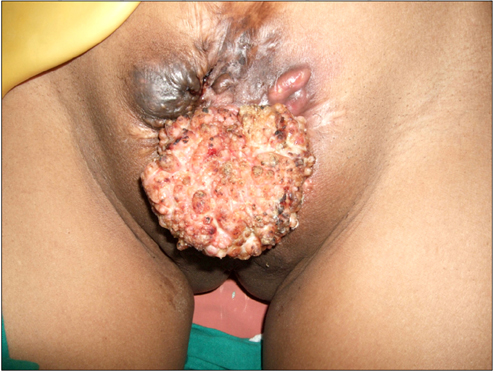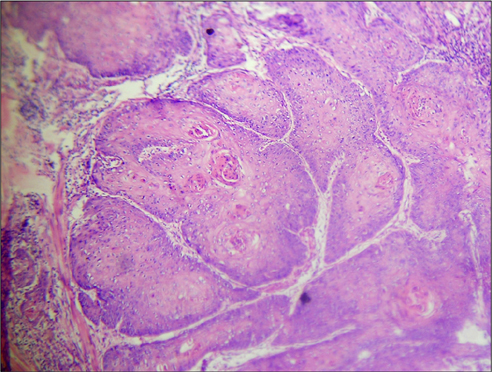Korean J Urol.
2013 Aug;54(8):555-557. 10.4111/kju.2013.54.8.555.
Squamous Cell Carcinoma in Exstrophy of the Bladder
- Affiliations
-
- 1Department of Urology, Institute of Post Graduate Medical Education and Research, Kolkata, India. surgpeekay@gmail.com
- 2Department of Pathology, Institute of Post Graduate Medical Education and Research, Kolkata, India.
- KMID: 1840470
- DOI: http://doi.org/10.4111/kju.2013.54.8.555
Abstract
- Exstrophy of the bladder is a rare congenital anomaly with an incidence of about 1 per 50,000 newborns. The malignant potential of the exstrophied bladder mucosa is well known; 95% are adenocarcinomas, and 3% to 5% are squamous cell carcinomas. Most of the malignant tumors (60%) associated with an exstrophy of the bladder occur during the fourth and fifth decades of life. Of the remaining, about 20% each occur after 60 years and before 40 years. Here we present a case in which squamous cell carcinoma developed in an unrepaired exstrophy of the bladder. We present the management of the case and a brief review of the literature.
MeSH Terms
Figure
Reference
-
1. Lattimer JK, Smith MJ. Exstrophy closure: a followup on 70 cases. J Urol. 1966. 95:356–359.2. de Riese W, Warmbold H. Adenocarcinoma in extrophy of the bladder: a case report and review of the literature. Int Urol Nephrol. 1986. 18:159–162.3. Gupta S, Gupta IM. Ectopia vesicae complicated by squamous cell carcinoma. Br J Urol. 1976. 48:244.4. Facchini V, Gadducci A, Colombi L, Ceccarelli P, Lamacchia M, Simi U, et al. Carcinoma developing in bladder exstrophy. Case report. Br J Obstet Gynaecol. 1987. 94:795–797.5. Serretta V, Pomara G, Piazza F, Gange E. Pure squamous cell carcinoma of the bladder in western countries: report on 19 consecutive cases. Eur Urol. 2000. 37:85–89.6. Kochakarn W, Kongchareonsombat W, Tirapanich W. Squamous cell carcinoma of the eviscerated bladder: a case report. J Med Assoc Thai. 2001. 84:735–737.7. Rieder JM, Parsons JK, Gearhart JP, Schoenberg M. Primary squamous cell carcinoma in unreconstructed exstrophic bladder. Urology. 2006. 67:199.8. Slaton JW, Swanson DA, Grossman HB, Dinney CP. A stage specific approach to tumor surveillance after radical cystectomy for transitional cell carcinoma of the bladder. J Urol. 1999. 162(3 Pt 1):710–714.9. Bango Garcia V, Lujan Marco S, Bosquet Sanz M, Gimeno Argente V, Arlandis Guzman S, Alonso Gorrea M, et al. Primary bladder adenocarcinoma in unreconstructed exstrophic bladder. Actas Urol Esp. 2009. 33:197–199.10. Kassouf W, Spiess PE, Siefker-Radtke A, Swanson D, Grossman HB, Kamat AM, et al. Outcome and patterns of recurrence of nonbilharzial pure squamous cell carcinoma of the bladder: a contemporary review of The University of Texas M D Anderson Cancer Center experience. Cancer. 2007. 110:764–769.
- Full Text Links
- Actions
-
Cited
- CITED
-
- Close
- Share
- Similar articles
-
- A Case of Female Bladder Exstrophy
- Initial Experiences of Complete Primary Exstrophy Repair in Cloacal and Bladder Exstrophy
- Bladder Exstrophy with Successful Initial Closure
- Analyzing the factors that contribute to the development of embryological classical type of bladder exstrophy
- A Case of Urethral Construction Using Paraexstrophy Flap in Newborn female with Classical Exstrophy






